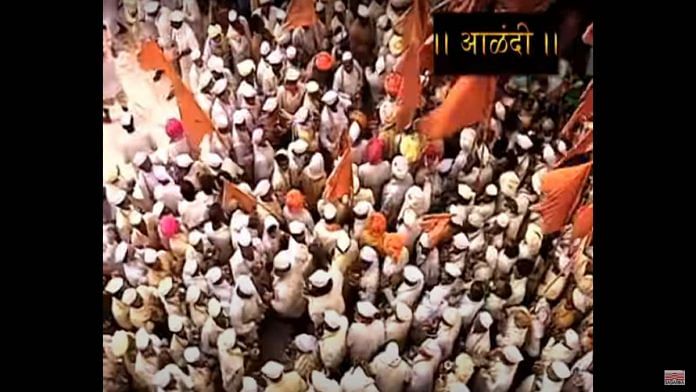Mumbai: Kirtans on YouTube, puja on Facebook Live, helicopters instead of a procession on foot, and a symbolic planting of trees in villages along the way — this is how organisers of the Ashadi Wari, usually Maharashtra’s biggest pilgrimage, are trying to keep the centuries-old tradition alive in times of social distancing.
With a sharp rise in the number of Covid-19 cases in the state, the Maharashtra government has decided to call off this year’s Wari, which translates to “journey”, perhaps for the first time in history. The decision came after Deputy Chief Minister Ajit Pawar held a meeting with the organisers last month.
However, some rituals of the pilgrimage will be observed under strict conditions set by the government.
Also Read: Sanitation tunnels, thermal screening, thin crowd — new normal at Delhi’s religious places
Strict time slots, restrictions on number of participants
Every year, lakhs of people from the Warkari sect, who follow the Bhakti tradition, walk to Pandharpur in Solapur district alongside decorative palanquins carrying the ‘padukas’ — or footprints — of the Bhakti tradition’s major saints.
Pilgrims reach the town, located on the banks of the Bhima River, on the eleventh day of the Hindu month of Aashad, also celebrated as Ashadi Ekadashi. The pilgrimage culminates at the feet of Lord Vitthal, considered to be an incarnation of Vishnu.
Speaking to ThePrint, Vitthal Joshi, executive officer at the Vitthal Rukmini Temple Trust, which functions under the state government, discussed how the pilgrimage will proceed this year.
“Since we can’t have a procession on foot, many of the palkhis (palanquins) that come to Pandharpur will mostly be reaching here by air this time. Usually, there are 18 palkhis of different saints that reach Pandharpur. This time, the state government has agreed to give permission only to eight.”
A state government official said, if the weather permits, the state will use helicopters to ferry the ‘padukas’. If not, these will be taken to Pandharpur in vehicles, the official added.
At Pandharpur, what is usually a 15-day celebration has been crunched into two days, with the government setting strict time slots for the entry of the eight palanquins into the Vitthal-Rukmini temple premises, Joshi said.
Each of the groups accompanying the palanquins is allowed to have no more than 10 people. The temple has been shut for devotees, in keeping with state government norms requiring all religious places to remain closed for now.
The temple trusts of Alandi and Dehu, from where the palanquins of Sant Dnyaneshwar and Sant Tukaram, the most revered saints in the Warkari tradition, start their journey, held small symbolic ceremonies last week to signify the beginning of the Wari.
An environmental pilgrimage
Every year, the palanquin processions halt overnight at villages along the way, where more devotees pay obeisance and attend ‘bhajan and kirtan (devotional sounds and spiritual talks)’ programmes organised for the Warkaris.
With there being no foot procession this year, the trustees of Alandi’s Sant Dnyaneshwar Temple have decided to hold a ‘Vriksha Wari’. As a symbolic gesture, the trustees will visit the villages along the way and plant trees instead.
“We don’t want to just mindlessly plant trees. We are reaching out to the gram panchayats of these villages, asking them the number and type of trees the village needs and identifying spots for the tree plantation,” said Vikas Dhage Patil, chief trustee of the Sant Dnyaneshwar Maharaj Sansthan Samiti.
The spiritual talks and devotional programmes for Warkaris, meanwhile, have moved to YouTube.
During the actual procession every year, the Warkaris organise themselves into smaller units called ‘dindis’.
Dhage Patil said, “We have asked all the 427 dindis that leave from Alandi to send us a detailed history of how they started, grew in size and so on. Many of these are over a hundred years old. We will put this up on our Facebook page for the Warkaris to feel more engaged despite the different form that this year’s Wari has taken.”
The Vitthal Rukmini Temple Trust had started an online darshan nearly two years ago by launching an app on Google Play store and tying up with Jio TV.
“Until now, there were hardly any users as devotees would prefer actually coming to the temple. Now, the number of online viewers has crossed a lakh,” Joshi said.
He added, “We started an online telecast on our website too, but we had so many users in such a short period that our website crashed.”
As of 17 June Maharashtra had recorded 1,16,752 coronavirus cases, of which 51,935 are active and over 59,000 have recovered. The pandemic has resulted in over 5,600 deaths in Maharashtra and it remains, by far, the worst affected state in India.
Also Read: Masked pilgrims, barbers in PPE and shorter queues as Tirupati temple reopens after 80 days



